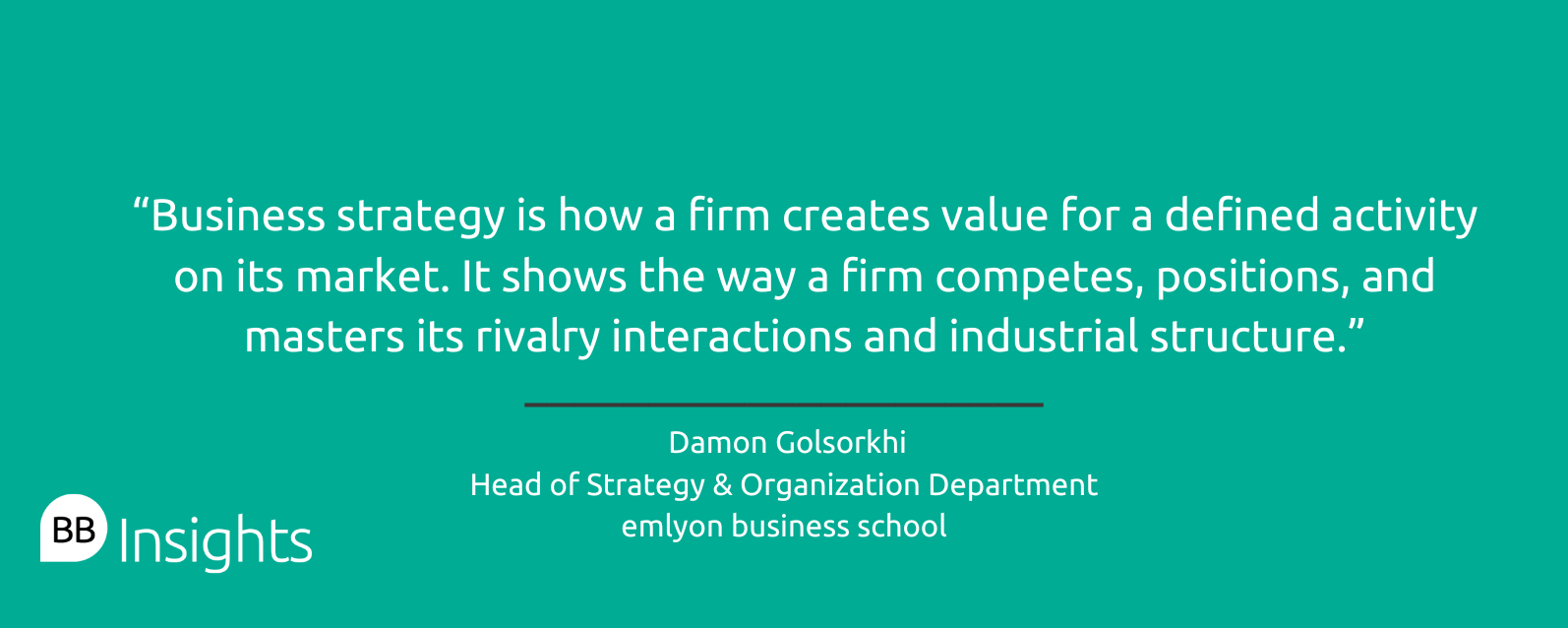There are typically three levels of strategy in an organization, all working together to help a business grow, scale, and compete for market dominance.
Think of it like the different players in a soccer team—multiple people assuming various roles to achieve the same objective. A conventional business consists of people at different levels of the organization working together to keep a business operating as it should and support wider organizational goals.
But what are the three levels of strategy in an organization, and what’s the difference between them? BusinessBecause spoke to business school experts to find out.
The difference between the three levels of strategy in an organization
Strategy is at the heart of any effective decision made by managers in an organization. A carefully planned out and intentional strategy will provide guidelines that can inform what business actions the employees of an organization need to take.
That could be a strategy to reach new customers, to enter a new market, or to rebuild a workforce around a specific goal.
On the other hand, a lackluster strategy that’s been implemented without any thought can result in a general lack of understanding among employees about a business and its environment.
Strategic decision making within any organization takes place on three levels. The difference between the three levels of strategy in an organization is the level at which they operate in a business. The three levels are corporate level strategy, business level strategy, and functional strategy.
These different levels of strategy enable business leaders to set business goals from the highest corporate level to the bottom functional level.
“For conventional organizations with a clear hierarchy, three levels of strategy are necessary to enable clear division of labor and accountability,” says Chengwei Liu, associate professor of strategy and behavioral science at Imperial College London.
What is corporate level strategy?
The corporate level is the highest point in an organization, so the decisions made here will ultimately inform the business’ main goal, as well as the goals of the levels further down the organization.
“Corporate level strategy involves the decisions that top managers make to enter and gain competitive advantage in multiple industries or markets,” says Sunkee Lee, associate professor of organizational theory and strategy at Carnegie Mellon University Tepper School of Business.
Corporate level strategy ensures that all business units are working towards a main overarching goal. The corporate level is also responsible for directing different business strategies across multiple business units.
“This top-level strategy is concerned with how the corporate parent can add value to its business units across multiple dimensions, such as the product or market scope, vertical scope, and geographical scope,” says Florian Bauer, chair in strategy at University of Bristol Business School.
Corporate level strategy examples
There are several key questions that corporate level strategy is aiming to answer.
One corporate level strategy decision is whether to forward or backward integrate, which is about identifying which stages in the industry value chain the firm is going to participate in, explains Sunkee from Carnegie Mellon.
Tesla is a good example. Here, Florian from University of Bristol Business School explains that backward integration would involve entering more ‘upstream’ businesses, such as the lithium mining business for the battery production needed for the company’s electric vehicles.
Meanwhile, forward integration would involve entering businesses that are more ‘downstream’. Think distribution or online dealerships.
Another key question answers how to manage the degree of diversification, says Florian.
A prime example of diversification at the corporate level is Amazon—the big tech giant has diversified into different business areas, covering ecommerce, streaming, grocery stores, and cloud-based web services.
A third core corporate level strategy decision relates to the geographic scope of the business. For example, Nike has retail stores all over the world, while the Macy’s department store has few stores outside the US.
What is business level strategy?
Business level strategy is concerned with designing ways for a business to gain a competitive advantage in a specific market.
“Business strategy is how a firm creates value for a defined activity on its market. It shows the way a firm competes, positions, and masters its rivalry interactions and industrial structure. For this purpose, the firm has to configure its value chain and [manage] its resources and capabilities to create a sustainable competitive advantage,” says Damon Golsorkhi, head of strategy and organization department at emlyon business school.
“Once you decide what business you’re in, then you need to decide who your customers are going to be, how you will attract them, and then encourage them to buy your product or service within an environment where other companies may be looking to capture those same customers’ attention, commitment, and money,” adds Jim Walsh, area chair of strategy at Michigan Ross School of Business.
If an organization consists of several business units operating in different business areas—like Amazon—specific goals and objectives need to be designed for each unit while also meeting the overarching goals set at the corporate level.
Business level strategy examples
There are three interrelated questions that must be considered within business level strategy, says Jim from Michigan Ross.
The first is about focusing on the customers. Jim says this involves asking what they need or want, and whether they have the desire to pay for high quality or coveted brands?
Take a designer clothing brand like Balenciaga, for instance, who sell trainers for upwards of $800 to a market of people willing to pay more for high quality products. Luxury brands like that will have conducted thorough market research to understand their value proposition, what their customers want, and the most they’re willing to pay for an item.
Secondly, organizations need to consider what resources and capabilities their organization can offer. Jim says this is about asking whether they can innovate and reliably produce a high quality good or service and whether they can do this at scale.
Lastly, firms need to scope out the competition and continue to provide a product or service that consumers choose over other similar products.
Take Apple, for example. Even though there are multiple tablets on the market with much more competitive pricing than an iPad, Apple’s product remains the market leader. This is largely due to the company's brand recognition and the image the firm has as a creator of quality technological devices and a master of innovation strategy.
What is functional level strategy?
Regardless of whether it’s the sales, marketing, or finance department, each functional area of a business should implement a functional level strategy to achieve its own goals, enhance operations, and support the wider business level strategy.
“Department managers or heads are usually responsible for functional strategies. Their formulation and implementation should connect to the organizational (or business level) strategy. For example, organizational level strategy should guide the research and development (R&D) department to focus on either new product development or existing product refinement,” says Chengwei from Imperial College London.
Functional level strategy examples
For functional level strategy to be successful, department managers will need to ensure the daily operations within each department align with the defined corporate outcomes. This will involve implementing specific measures to track whether each area is meeting broader objectives.
Functional strategy examples include a company’s marketing strategy, financial strategy, production strategy, or R&D strategy. Each of these separate strategies will require different tactical decisions to meet the wider corporate level strategy.
“A key skill or quality for departmental leaders responsible for functional level strategy is communication: understand how to translate organizational level strategy into strategies at the functional level and at the same time provide feedback when organizational level strategy needs to be revised,” says Chengwei.
Whether you’re making decisions at the corporate level, the business level, or the functional level, to be successful in business you need to become a confident strategic manager. This requires an in-depth understanding of the customers’ wants and needs, your business’ position in the market, and your own firm’s mission.
All three levels of strategy are equally important to meeting the overall corporate goals, and if you’re someone looking to run their own business one day, you’ll need to inspire all business levels to work in symbiosis to reap business success in a competitive market.
BB Insights draws on the expertise of world leading business school professors to cover the most important business topics of today.






